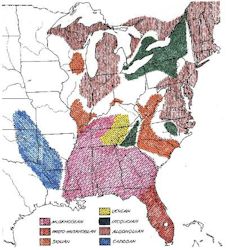Many of the protected sites may have been constructed and occupied by the Iroquoian tribes during the movement northward, and consequently a comparative study of the archeological material recovered from them should prove to be of the greatest interest. If this hypothesis is correct, it is probable that before the Iroquoian tribes had reached the left bank of the Ohio the Siouan peoples were living in security in the upper valley of the stream. The great majority were north of the river, but others, including the Catawba, may have been south of the Ohio in the mountains to the eastward. The region northward from the Siouan territories, extended to the shores of the Great Lakes, was probably at that time occupied by Algonquian Indians.
The relative position of the Siouan tribes when they occupied the Ohio valley, claiming the southern section of the present State of Ohio, has been suggested by Swanton, 1 who wrote in conclusion:
“The occupancy of the territory of our Middle West between the Great Lakes and the Ohio by Siouan tribes seems therefore to rest on grounds almost historical. With the strong indications now at hand there seems to be reason to think that a close comparative study of the Siouan dialects would enable us to reconstruct the general outlines of their ancient geographical positions with considerable accuracy. If present indications are not deceptive, when that is done we shall find that they fell into four major linguistic groups; a northeastern, consisting of the ancestors of the later Siouan tribes of Virginia, the Hidatsa, Dakota, Biloxi, and Oto; a southeastern, including most of the later Siouan peoples of the two Carolinas; a southwestern composed of the five tribes of Dorsey’s Dhegiha group; and a northwestern, Dorsey’s Tciwere.
“Admittedly there is much of speculation in all this, but I have considered that the facts are of sufficient importance to both the ethnologist and the archaeologist of the Ohio region to present them in usable form.”
The five tribes included in Dorsey’s Dhegiha group are the Omaha, Ponca, Quapaw, Osage, and Kansa. The Tciwere group consists of the Iowa, Oto, and Missouri.

There is historical proof that one or more Siouan villages remained in southern Ohio until late in the seventeenth century, and tribal traditions place the ancient settlements of the Quapaw and Osage near the junction of the Ohio and Wabash Rivers.
The line of contact between the Algonquian and Siouan Indians appears to have been to the north and east of the area occupied by the latter peoples.
Michelson 2 in a recent article discussed certain phases of the Algonquian languages, and in closing wrote: ” Summing up, we may say that Powhatan clearly belongs with the Cree group of Central Algonquian languages, that it is closer to Cree than to any other member of that group, but that it call not be classified as a Cree dialect. A prehistoric migration is thereby shown.” “Powhatan” in this quotation refers to the language spoken by the Algonquian tribes of tidewater Virginia in the early seventeenth century.
From the two quotations just made it is evident that some centuries ago the Siouan tribes who later reached the mountainous country of Virginia were living in close contact with others who moved westward beyond the Mississippi; also that the Algonquian tribes encountered in Virginia by the first colonists had been separated from some related tribes with whom they had formerly been closely associated.
The northern thrust of the Iroquoian peoples, when they crossed the Ohio from the south, is now suggested as the cause of the separation of tribes that belonged to the Siouan and Algonquian groups, some going eastward and south, others seeking new homes toward the west.
Where the Iroquoian tribes may have crossed the Ohio is not known; however, if the line of fortified camps, already mentioned, prove to have been associated with the movement of the tribes, the approximate locality of their crossing will be suggested. But it is not within reason to suppose that all reached the right bank of the Ohio at the same time or at the same place, and some may have followed up the valley of the stream from its mouth.
The Cherokee were at that time a part of the Iroquoian group and as such would have participated in the movement from west of the Mississippi; however, they may have continued eastward to the mountains without having crossed the Ohio, thus approaching the Country where they were first encountered by Europeans. Probably the Catawba and other Siouan tribes who occupied parts of Carolina in historic times then moved away from the Ohio valley and advanced farther southward into the mountains.
Citations:
- Swanton, John R., New light on the early history of the Sioun peoples. Journ. Washington Acad. Sci., vol. 13, no. 3, Feb. 4, 1923.[
]
- Michelson, Truman, The linguistic classification of Powhatan. Amer. Anthrop., vol. 35, no. 3, July-Sept., 1933.[
]
